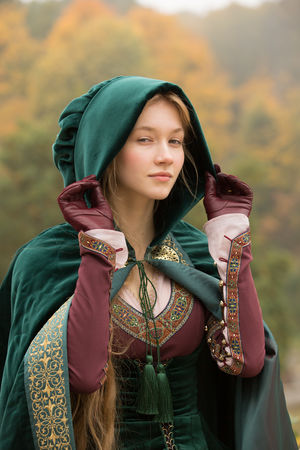News - A brief history of cloak from vikings to modern superheroes
There is always something special about a person wearing a cloak, even if it's not a stylish black hooded cloak of an ultimately evil character or a superhero cape. How did the cloak have taken its place in modern culture? Let's delve into the history a little.
Etymology and the first mentions
The word cloak comes from the Old French “cloque” meaning “bell” inherited from Medival Latin “clocca” – a travelers' cape of a bell shape. The word “hood” accordingly comes from Old English hōd, or Dutch hoed, having the same meaning as a “hat” and relating to the Old Norse hǫttr “hood”. Early cloaks, worn by Romans and Greeks, hematons and palliums, had a rectangular shape, and toga, which technically can be classified as a cape, was formal clothing outlining Roman citizenship. Also, cloaks possibly played a role of ritual outfits in ancient civilizations of Egypt and North America. The first cloaks were simple and had two applications, a religious and a practical one, possibly starting a tradition of wearing a cloak as a symbolic outfit for specific occasions or spiritual needs.
A Viking cloak – a practical simplicity of the Nordic clothing.
The times of the Old Norse rise in power are one of the most popular periods in reenactment and LARPing. The simplicity and practicality of the Viking wardrobe defined a lot of tendencies in many cultures that intersected with Vikings, for good (trade routes) or for ill (“Save us, O God, from the wrath of the Norwegians.”)
Take a look at our Viking capes:
 |
 |
 |
A rectangular cloak called “feldr” is well-known and historically accurate. While practically being a rectangular woolen or leather blanket, the way Vikings wore it was the first attempt to build a hooded cloak. Though feldr was often worn just as a simple cape, making a hood by putting a clasp properly and creating a hood with a middle segment of this Viking cape was also possible.
 |
 |
A black cloak: from the Middle Ages to popular culture
A black cloak with a hood inherited a significant cultural background from different periods and cultures. Tolkien's Nazguls, Star Wars Sith, Zorro, Batman, Corwin of Amber, and Jon Snow – the list of heroes and antagonists wearing a black cloak is endless, the same as the list of real historical characters wearing one once in a while.
On ArmStreet:
Historically, the period we could vaguely consider as a beginning of European medieval fashion is the end of the XI or beginning of the XII centuries when the feudal rule in most of the Western European countries became stable enough to provide some basic safety for travelers and the trade started to influence the cultural exchange and, as a result, fashion.
 |
 |
Hooded cloak: from the Middle Ages to modern times
Clothing was expensive, and for many centuries, a cloak was a privilege of the upper classes, serving both the practical needs of protecting the owner from the elements and supporting privacy and anonymity.
ArmStreet hooded cloaks:
 |
 |
A person wearing a wide cloak with a deep hood is very hard to recognize, so the hooded cloak had this practical and cultural aspect of clothing associated with romantic adventures, dangerous travels, and confidential meetings. We know that for many religious, mystic societies and secret groups, a hooded cloak was one of the main elements of the garb, usually shifting from practical to symbolic use. Still, nowadays, a deep hoody plays the same role, hiding the faces of protestants and adding an extra mystery to the character of boxers, martial artists, celebrities, and religious figures.
 |
 |
 |
Cloaks of Renaissance
One of the most inspiring historical fashion periods has brought us a lot of new sophisticated designs of classic hoods and capes, and the focus has shifted from practicality to elegance and status. That's how intricate embroidery and complex hood designs appeared on the traditional capes, and we can find endless pictures of noble men and women wearing hooded cloaks and shorter capes and pelerines as their everyday outfits.
Armstreet Renaissance cloaks:
 |
 |
The closest thing to the medieval cloak in our modern lives is, surprisingly, a modern raincape, often made of plastic fabric and very simple. Nevertheless, if you add a little bit of imagination, a little bit of extra material, and a little bit of style, you'll get a perfect hybrid of a medieval cloak and a modern rain cape.
 |
 |
If you do LARP, go to SCA events, participate in Renaissance Fairs, or do any other sort of outdoor costuming, a warm, wide, long cloak with a hood will be a considerable improvement to your outfit, bringing both extra style and comfort into your history-related life.




























